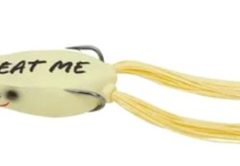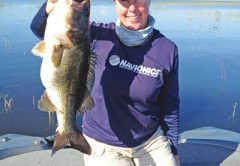There are many invasive fish species in Florida’s waters but few match the size and strength of the Black Pacu. Native to the South American Amazon Basin the Black Pacu looks similar to its second cousin, the Piranha, but they are much less dangerous then the razor toothed Piranha.
First observed in the wild in Florida during the 1960’s, the Pacu population is thought to be non-breeding and exist only as the escapees of residential aquariums. Yet they are everywhere, from South Florida canals, to Lake Okeechobee and through-out most of the continental Untied States. They are such a hardy species that they have been found as far north as a few Michigan lakes and the Hudson River of upper New York State.
Their body shape is that of a supersized Tetra, with a deep thick back and powerful tail. There are many hybrids of Pacu though the most common species are the Black Pacu and the Red Bellied Pacu. Black Pacu have an elongated body with a lateral line running down the side which separates the black upper body from the grayish lower body. Red Bellied Pacu have a rounder shape, they are generally smaller in size, and they have a red to orange belly. One of the distinguishing features of the Pacu are their teeth which more resembles human or horse teeth than your typical fish teeth. These teeth are strong and are used to crush fruits, nuts and seeds. So if you ever have the opportunity to be near a Pacu, keep your hands clear of these finger crushers.
Black Pacu grow to considerable size with the IGFA World All Tackle record being 55-lbs caught on Oct 5, 2010 by Gary Roberts in Tamarac, FL. Reports of 40 to 50-lb fish are common throughout south-central Florida. The Florida Fish and Wildlife Conservation Commsssion (FWC) does not keep any official weights or records on Pacu. Being an invasive species there are no regulations on the harvesting of Pacu and the FWC prefers you not to return the fish to the water.
Pacu are considered to be mainly herbivores feeding on plants, fruits, and nuts. However similar to Tilapia and Peacock Bass they will also feed on worms, grubs, grass shrimp and other invertebrates. Larger Pacu are also known to be opportunistic feeders and take shiners, small stick baits and spinners. However there just seems to be something ‘off’ in using dough balls for fish that weigh 30-lbs or better. Pacu are typically found in slower moving waters, lakes, and ponds. If they’re in your local waters you’ll most likely to find them under an overhanging tree feeding on the fruits, berries, and leaves that fall into the water. In deeper canals and channels, you’ll find them cruising the first drop-off feeding on the items that roll-off the shelf and into the depths of the canal. The bigger they are the more diverse their diet will be.
In Brazil and other parts of the world where Pacu are abundant, Pacu is a major source of protein and are quite tasty. In the U.S., with their limited numbers they are considered a by-catch and have little impact as a protein source.
In recent years some upscale seafood restaurants have begun to add Pacu ribs to their menus. A large Pacu has a sizable rib cage and slicing the fish vertically along the rib cage will produce a nice set of ribs. Marinate them in a sweet tropical bar-b-que sauce, toss them on the grill for a few minutes, and you’ll have a unique and tasty treat. If you’re a fan of Chef Guy Fieri of the Food Network fame, he has an episode on Diners, Drive-ins and Dives that features Brazilian grilled Pacu ribs that should open up your mind and palate to cooking Pacu (http://www.foodnetwork.com/videos/pacu-ribs-0158590.html). Who knew that a fish typically found as an aquarium pet could taste so good.
[easy-social-share]






